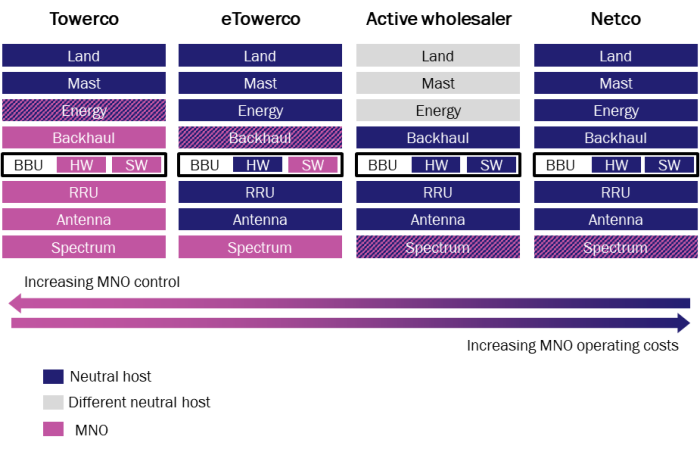Neutral host models could create opportunities for investors in rural areas
Mobile network coverage is not ubiquitous, and mobile operators face pressure to roll out networks in scarcely populated areas
Mobile network operators are used to reporting their network coverage figures in terms of the percentage of the population, which can give the misleading perception that mobile network signal is ubiquitous across the country. However, the territory coverage is often far from complete and can be improved to include areas with low population density and areas at the edge of existing cells that have a poor-quality service.
Policy makers and regulators are making an effort to improve coverage. They are implementing spectrum licence conditions such as a requirement for the provision of high-quality connectivity along major transportation corridors and the extension of service coverage to specific remote municipalities with no or poor mobile signal.
Operators can reduce to cost of network roll-outs in remote areas by sharing infrastructure with their competitors
The revenue upside from extending coverage is limited: there is not much additional revenue to be gained through an increase in traffic or an increase in the number of subscriptions or paid-for calls. Retail competition and downwards pressure on mobile ARPU makes the business case even more challenging.
This puts the need to reduce the total cost of ownership (TCO) of the radio access network (RAN) into focus. This can be achieved by various means including by sharing infrastructure with competitors. Passive infrastructure sharing in remote areas offers a TCO reduction of around 20–25%,1 which is substantial but not sufficient when it comes to rolling out in very remote areas. Active sharing offers a more compelling reduction in TCO of approximately 45%. It is therefore not surprising that we see more and more infrastructure sharing deals between operators via either active RAN sharing or national roaming (which is similar to sharing in that it carries two operators’ traffic on one network).
Neutral hosts can support operators with their rural roll-outs
Privately funded neutral host models can offer several advantages over operator-led initiatives. They can bring capex savings for cash-strapped operators, and can also be used to bypass arguments between the sharing operators if the benefits of sharing are not evenly distributed. Neutral host models also enable competition-preserving features of sharing deals such as the ability to differentiate on SLAs or to have different coverage/upgrade strategies.
The neutral host model can take different forms depending on the market context and mobile operators’ appetite for surrendering control
Neutral host models can vary in terms of what assets are included in their perimeter of operations (Figure 1). Options include real estate, masts/towers, energy (equipment and management), backhaul (for example, fibre), base stations (the hardware and/or the software of baseband units (BBUs) and remote radio units (RRUs)), antennas and frequencies.
Figure 1: Overview of the perimeter of selected neutral host business models

Source: Analysys Mason, 2021
Operators need to accept the trade-off between reducing costs and retaining operating control over the network. Some have already started to back rural neutral host models in emerging markets (for example, Africa Mobile Networks). These players tend to be netcos that have adopted a coverage-as-a-service model and have control of active and passive equipment alike, but do not own spectrum. This model has not been used in developed markets yet.
The virtualisation of the RAN will offer new options to neutral hosts. Vendors currently sell base stations as proprietary solutions that include both hardware and software. In the future, the software will be decoupled from the hardware, which will potentially reduce both deployment capex and operating costs. The hardware can then be an off-the-shelf server owned by the neutral host, which will offer operators/tenants the ability to run their own software. This approach would allow mobile operators to further reduce the TCO of remote sites and yet maintain control of the most critical part of the RAN.
New rural deployments in Europe could be the ideal testbed for this business model as they represent a limited risk to operators. If successful, the model could be replicated deeper in the network. O-RAN is being trialled by several European MNOs in rural areas and could also play a role because it could further contribute towards reducing the TCO.
The neutral host model can easily be applied to other attractive use cases
Rural area roll-outs are just one of the use cases where neutral hosts can play a role. The evolution of mobile markets and technology offers compelling opportunities to investors that are bold enough to innovate and partner with operators to address market niches that are expected to rapidly grow in size, such as in-building solutions, private networks, specific solutions for railways and smart motorways and smart cities. Investors should consider how to monetise these opportunities from the start in order to build knowledge, relationships and a track record, and to avoid missing potentially narrow windows of opportunity.
Conclusions
Financial investors have the opportunity to support the roll-out of new connectivity infrastructure beyond the more-traditional fibre, towers and data centres. Strategic investors must continue to monitor technology dynamics and be responsive to their customers’ requirements by experimenting and collaborating with them on new business models. Opportunities for investors stem from the expanding ecosystem, which includes private network providers, in-building solution providers, specialised neutral hosts, new hardware and software vendors and telecoms infrastructure service companies.
Analysys Mason has a strong track record working alongside strategic and financial investors in the mobile infrastructure space and has completed over 100 tower-industry-related assignments in the last 5 years. This includes work across the five continents, and in both developed and emerging markets. Analysys Mason has a 360-degree view of the mobile industry and in-depth knowledge of the commercial, technological, operational and regulatory aspects of the business. This unique positioning makes Analysys Mason the ideal partner to telecoms stakeholders.
For further details, please contact Alessandro Ravagnolo.
1 We have calculated the TCO based on the 20-year undiscounted cashflow assuming that two operators share the site. The savings may vary significantly by country. Cost inputs based are on project estimates.
Article (PDF)
DownloadAuthor


